India's Third Giant Leap
This Could be One of the Biggest Opportunities for Investors
- Home
- Views On News
- Sep 17, 2022 - India's 7 Most Favourite Stocks
India's 7 Most Favourite Stocks

What was your favourite toy when you were young?
For me, it was my collection of G.I. Joe action figures. I would save up all my pocket money for months just so that I could add one more figure to my collection.
Our favourite toy or possession is always the one that speaks most directly to us at a particular stage in our lives.
And as we grow older, our lives change. We have other favourites that give us what we need most at that particular stage in time.
But we never lose our old favourites, do we? They are always with us. We just sort of add more of them over time.
As adults, our favourite possessions tend to be our investments, particularly stocks.
And just like our toys, we may buy new stocks every now and then based on a market trend or tip at a point in time. But we never lose our old favourites that we hold on to and treasure. We accumulate some more at every opportunity we get.
With over 5,000 companies, the Bombay Stock Exchange has the largest number of listed companies in the world.
Yet, there are just a handful of companies most favoured among investors across generations.
In this article, we unravel the 7 most favourite stocks in India based on retail holdings ranked in increasing order and some surprising trivia about these companies that you may not be aware of!
7. Asian Paints Ltd
Asian Paints is India's leading and Asia's third largest paint company. It operates in 15 countries with 26 paint manufacturing facilities in the world. The company caters to consumers in over 65 countries.
As per the shareholding pattern for the quarter ended 30 June, retail investors hold 11.9 crore shares, i.e. 12.5% of the total shareholding in the company.

The marketcap of the company at the current price of Rs 3,400 is Rs 271,000 cr of which retail investors hold shares worth Rs 40,700 cr.
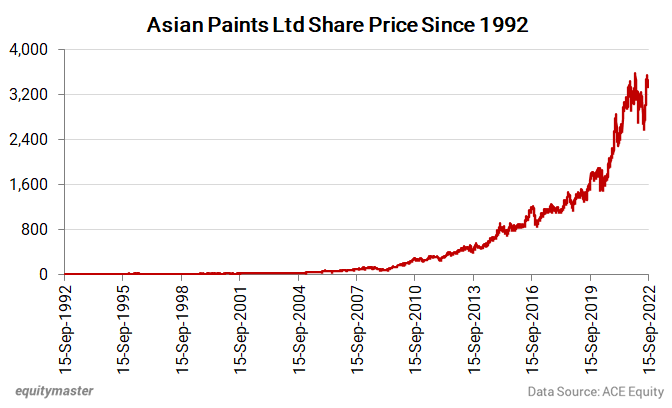
Asian Paints has delivered a 24% CAGR over the last thirty years. Rs 1 lakh invested in the company in 1992 would be worth over Rs 5.6 cr today. No wonder this stock continues to remain a favourite among investors.
Did You Know: In 1942 Asian Paints was founded by four friends in a small garage in Mumbai. By 1967, it had become the largest paint company in India.
In 1970, Asian Paints bought a mainframe computer for Rs 8 cr, becoming India's first private company to ever buy a computer. This was 10 years before ISRO and IIT Bombay had used a supercomputer and 21 years before any other company in India.
The computer was not used for administrative processes, but for demand forecasting and improving service levels across the country.
6. Infosys Ltd
Infosys, India's second-largest IT company, has consistently ranked among the most respected companies in the world.
Retail investors hold 30.53 cr shares in the company. Although that is only 7.2% of the total shareholding, it is valued at over Rs 43,500 cr at the current market price.

Infosys has remained investors' favourite stock for a while now. But when the Infosys IPO that was launched in June 1993, it was undersubscribed and had to be bailed out by its underwriters.
Rs 10,000 invested in the IPO is now worth over Rs 2 cr. It has paid almost Rs 20 lakh in dividends since listing.
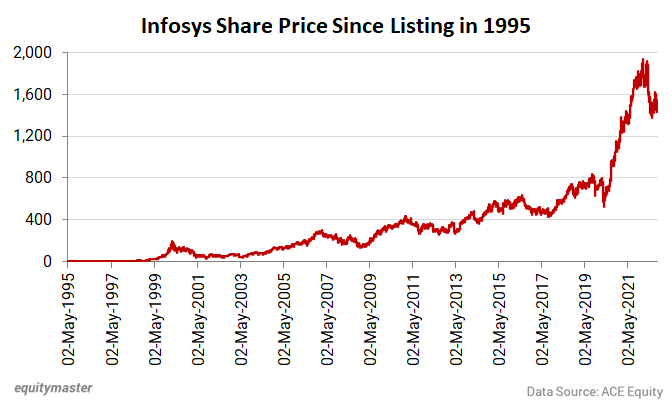
Fun Fact: Today's second-largest Indian IT company did not have a computer for 2 years when it was established due to lack of funds. It took Infosys about 2 years to buy a high-quality computer with its own funds!
Before Infosys, Narayana Murthy had failed at his previous start-up, Softronics and had no money.
Murthy borrowed Rs 10,000 from his wife Sudha Murthy who was an engineer at Tata Steel and started the company along with his 6 other friends.
Surprisingly, Narayan Murthy was not the first employee of the company. It was S Raghvan. In fact, Murthy was the 4th employee, as it took him 1 year to finish his pending work with his former employer, Patni Computers.
5. Tata Consultancy Services Ltd
Where there is Infosys, TCS is sure to be around.
Just as TCS ranks first above Infosys as the leading IT company in India, here too, TCS finds itself a spot above Infosys as the fifth most held stock by retail investors.
The promoters hold a majority stake in the company of 72.3% leaving very little free float in the market. Yet, the 4.4% held by retail investors in the company is still valued at over Rs 50,000 cr making it the 5th most favourite stock on our list.

TCS has created phenomenal wealth for its shareholders since its listing in 2004 and has always been among the most admired companies of India.
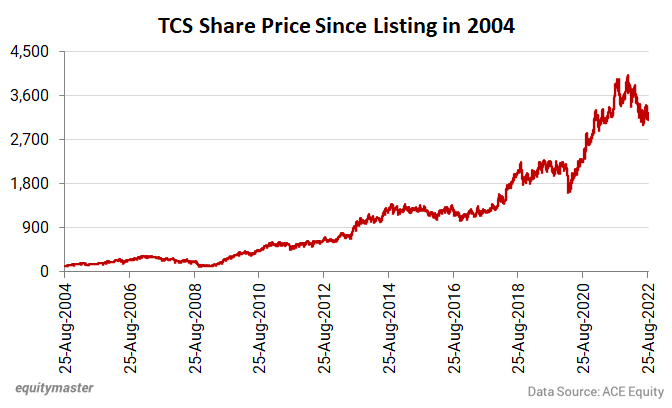
If you had invested Rs 1 lakh in TCS shares at the issue price of Rs 850 in the IPO in 2004, the value of that investment today would be around Rs 3,176,000, a return of almost 3,000%.
The company dominates the information technology industry in India. It's the second-largest IT company globally. It has set a goal of US$ 50 bn in revenue by 2030.
Interesting Trivia: In 1970, TCS acquired an ICL 1903. However, the stringent import restrictions meant that TCS received permission to import the computer only after committing to export twice its import value over the next five years.
This effectively oriented TCS to look outside to drive its business. It was the beginning of the Indian outsourcing model.
Just six years later, the company crossed the US$ 1 m mark in export revenues in 1976 becoming the top exporter in India.
Ironically, in 1992, TCS set up the core trading platform for the newly created National Stock Exchange, on which it went on to become the first Indian company to reach US$ 100 bn market capitalisation!
4. Larsen & Toubro Ltd
Larsen & Toubro Ltd, commonly known as L&T is India's largest engineering company. It's counted among the world's top five construction companies.
Much before 'Make in India' became a buzzword, L&T has been making outstanding offerings not only to India but also the world.
This has made the company synonymous with the growth of the nation instilling pride in its shareholders.
Larsen & Toubro is not a typical promoter driven company. In fact, the company has zero promoter holding and is one of the few truly professionally managed companies in India.
Retail investors hold 20% stake in the company valued at over Rs 54,000 cr as on date.

The company has rewarded investors with 10 bonuses over the last 7 decades and the CAGR for L&T investors over the last 20 years stands at an impressive 25.6%.
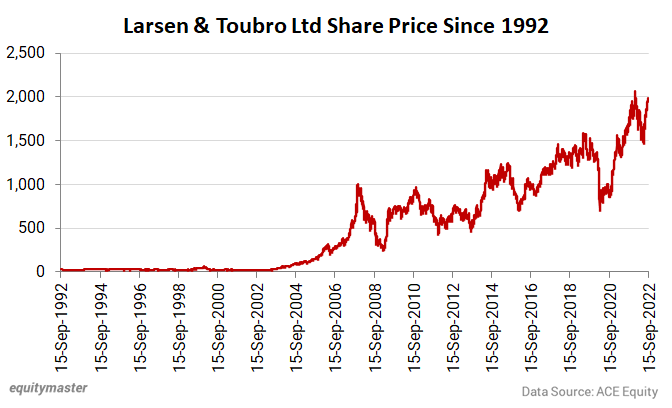
Interesting Tidbit: L&T has a dramatic saga of hostile takeovers.
In the 80's when a British businessman, Manu Chhabria started acquiring shares of the company, the management soon acknowledged that he was interested in taking over L&T.
The chairman of L&T approached Dhirubhai Ambani to protect L&T from the takeover and invest in the company as a white knight.
Ambani didn't let the opportunity to pass and bought 12.4% from the open market.
But Ambani had a different agenda. He continued to buy shares from the open market and increased his holdings to 18.5%.
Soon the tables had turned! It was evident that Ambani was the one trying to takeover L&T.
However, when the Congress party, allegedly a supporter of the Ambanis back then, lost power in 1989, the new government intervened. It made sure the Ambanis were out of the company, and were forced to resign from the board.
Following this, Ambanis remained passive investors in L&T for over a decade and in 2001 sold their entire stake to Aditya Birla Group company Grasim, L&T's competitor in the cement industry.
The company fought tooth and nail against the entry of Birla's and after months of negotiations, Birla finally exited L&T, selling its stake to an employees' trust run by L&T employees in June 2003.
As a trade-off, Birlas acquired L&T's cement division and named it UltraTech.
But the prey itself became the predator.
In 2019, the acquisition of Mindtree, one of India's leading information technology companies by L&T, made headlines for several days as a result of it being India's first hostile takeover in the IT sector.
3. Hindustan Unilever Ltd (HUL)
Ask any old timer in the stock market about the top five stocks to buy and there is a high probability the list would include Hindustan Unilever. That was just how a whole generation of investors made huge wealth.
No wonder HUL is one of India's most favourite stocks of all time.
With nearly 90 years of heritage in India, Hindustan Unilever Limited (HUL) is India's largest fast-moving consumer goods company. The company has been rated as the most innovative company in India over the years.
As per the shareholding pattern for the quarter ended 30 June, retail investors hold 26.3 cr shares, i.e. 11.2% of the total shareholding in the company.

At the current price of Rs 2,500 this holding is valued at a staggering Rs 67,000 cr making it number 3 on our list of most favourite stocks of India.
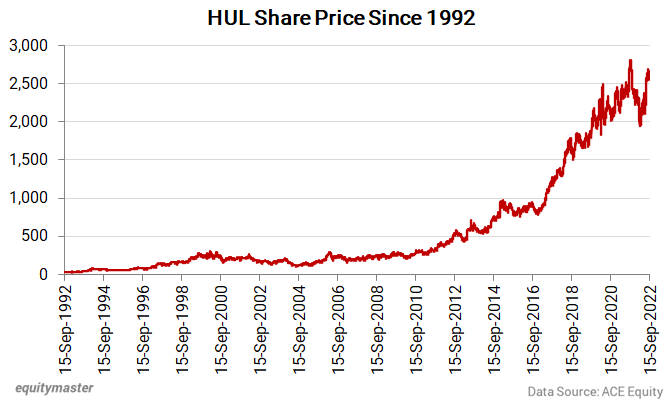
Loyal shareholders held on to shares of HUL, even though it went into a coma for 13 long years between 1997 to 2010, where the stock price hardly moved.
But since then, the company has compensated investors by becoming a multibagger with a CAGR of 21.3% over the last 12 years.
Interesting Facts: What do 9 out of 10 Indians have in common? On any given day, nine out of ten Indian households use one or more of HUL's brands!
HUL has been among the largest spenders on advertisements in India over the last few decades. In the financial year ended March 2022 the company spent over Rs 4,700 cr on its marketing!
Its advertising strategy has been one of the key reasons behind the company's success in creating leading housing brands over the years. One such case is of Close Up toothpaste.
When launched in 1975, Close Up wasn't able to offer much resistance to market leader Colgate.
In the 1980s, HUL relaunched Close Up in India as the first-ever gel toothpaste packed in a transparent tube and its target was young Indians.
Close Up offered something new and surprising in "fresh breath", "shiny teeth" and the resulting confidence for young men and women. The advertising, featuring young people in various romantic situations, supported the message. The impact was instantaneous. Over the next 2-3 years, Close Up grabbed nearly 20% of the market share from a shell-shocked Colgate.
2. HDFC Bank Ltd
Which is the best bank in India? The leading bank in India? Favourite Bank of India? No guesses here. It's HDFC Bank.
And perhaps that is why it also finds itself in runner up position on our list of the most favourite stocks of India.
HDFC Bank was incorporated in 1994 as a subsidiary of the Housing Development Finance Corporation (HDFC). It went public in 1995 and to date, it has generated a CAGR of 31% for its shareholders.
That means if you had invested Rs 10,000 in HDFC bank's IPO in 1995, today your investment would have grown to Rs 1.52 cr.
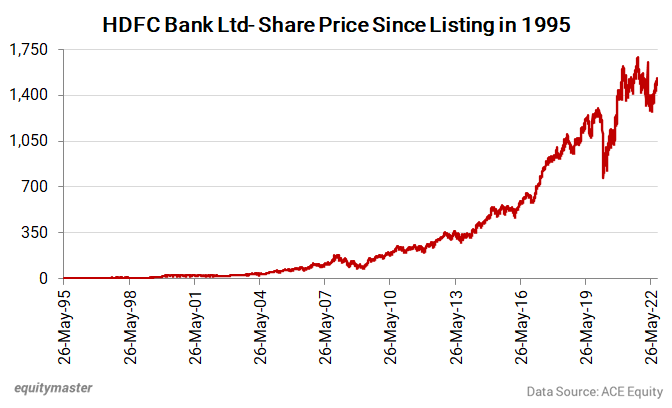
The current marketcap of the company stands at Rs 831,000 cr making it the second most valued company in India.

Retail investors hold 48.8 cr shares, the second highest holding by small investors in any company in India. This 10.8% stake is valued at a colossal Rs 74,000 cr at the current market price.
Did You Know: When approached by now fugitive businessman Vijay Mallya for a loan, Former HDFC MD & CEO, Aditya Puri offered him coffee but refused to extend a loan even though he was his friend.
Hence, it was one of the few banks which had zero debt exposure to Kingfisher Airlines.
Such clear thinking about lending and risk management is why the stock commands one of the highest premiums across global banks.
Deepak Parekh, who headed parent HDFC Ltd wanted to call the new bank, 'Bank of Bombay'. This was because it was the only one of the 10 new banks set up after the 1991 reforms to have its headquarters in Mumbai.
Parekh is not on the board of HDFC Bank but attends most of its board meetings as a 'special invitee'.
And finally, we are at the end of our list. The most favourite stock of India is...
1. Reliance Industries Ltd
Investors love profitable companies...
And perhaps this company is loved even more as it happens to be the most profitable company in the country.
Reliance Industries Ltd (RIL) has been an investors' favourite since its IPO in 1977, and why not?
The stock has been the finest investment proposition ever seen by the Indian shareholder doubling investors wealth every 2 years for the last 45 years!

An investment of Rs 10,000 in the IPO of 1977 would have turned into Rs 5.18 cr, a massive 518,000% surge over its issue price.
In the 1970s, participation in the Indian capital markets was largely limited to rich businessmen and brokers.
When banks and financial institutions refused to lend money to Dhirubhai Ambani for his new projects, he brought first-time retail investors into his then relatively unknown company by floating an IPO.
This was the first-time funds were raised from the masses, in the process creating one of the world's largest shareholder families.
Retail investors hold 49.4 cr shares in the company valued at a mammoth Rs 125,000 cr making it the largest retail holding in any listed Indian company.

Unknown Facts: Contrary to popular belief, Reliance did not start its business with the textile industry but rather by selling spices.
Reliance Industries is Asia's largest mango exporter!
After receiving several warnings from the Pollution Control Boards over its refinery in Jamnagar, in 1997, Reliance decided to create a mango orchard near the refinery to curb the pollution levels.
The wastelands near the Jamnagar refinery of Reliance were then converted into a green belt, and around 1.3 lakh plants of mangoes of over 200 species were planted there.
Today, the company produces about 600 tonnes of mangos a year.
In 1986, the company's annual shareholder meeting was attended by as many as 30,000 shareholders, a record in India's corporate history. As no hall in Mumbai could hold that number, the meeting had to be held in Cross Maidan.
In Conclusion
As on 30 June 2022, the retail holding in companies listed on NSE stood at Rs 17.5 lakh cr.

It is phenomenal that just seven of these companies on our list contribute to almost 26% of the total retail holding value, i.e. Rs 4.5 lakh cr.
And it doesn't look like these "most favourite" stocks will fall out of favour any time soon...
Disclaimer: This article is for information purposes only. It is not a stock recommendation and should not be treated as such. Learn more about our recommendation services here...

Yazad Pavri
Cool Dad, Biker Boy, Terrible Dancer, Financial writer
I am a Batman fan who also does some financial writing in that order. Traded in my first stock in my pre-teen years, got an IIM tag if that matters, spent 15 years running my own NBFC and now here I am... Writing is my passion. Also, other than writing, I'm completely unemployable!
Equitymaster requests your view! Post a comment on "India's 7 Most Favourite Stocks". Click here!
4 Responses to "India's 7 Most Favourite Stocks"
Dr Bhanwar Singh Rana
Sep 26, 2022The Equity market, has indeed lot of money but one should have lot of knowledge , courage and correct guidance. After lot of IPO mess of 1990 decade cleared at loss, I retained six shares of the list except HUL. Wish I would be a subscriber of stock select for the last 30 years.
Ravi shah
Sep 19, 2022Mr Yazad it was very interesting to read this article.Since being an investor,is very boring we can not trade everyday we need such article to keep us busy and lately EQM has improved a lot where we get to read such article and update ourselves.pl keep writing such informative pieces.Thanks alot.


Vijayakumar
Oct 26, 2022Good analysis. But there is mistake. Rs 9500 invested in 100 shares of Infosys in 1993 (IPO) is now worth not Rs 2 crores but more than Rs 15 crores. 100 shares have become 102400 shares after bonus issues and stock split.